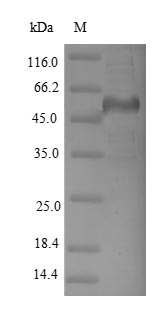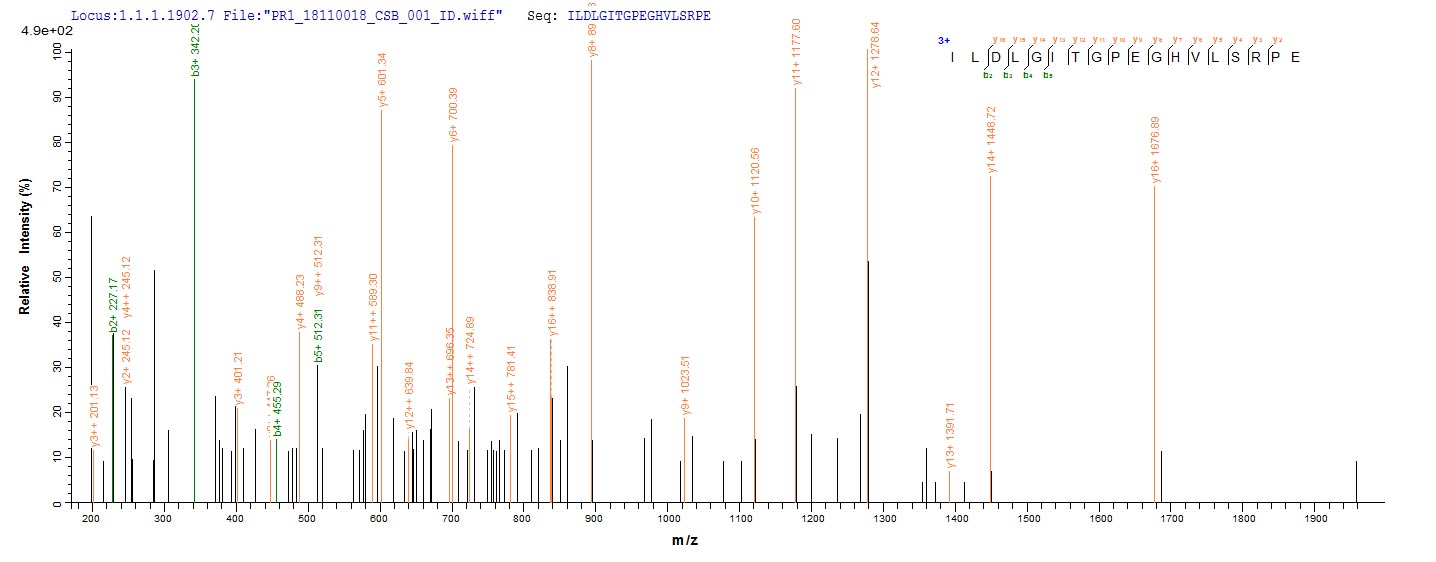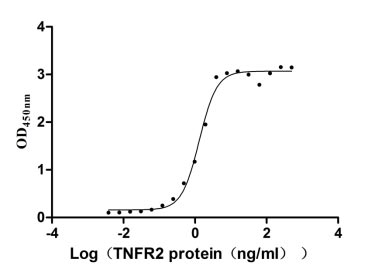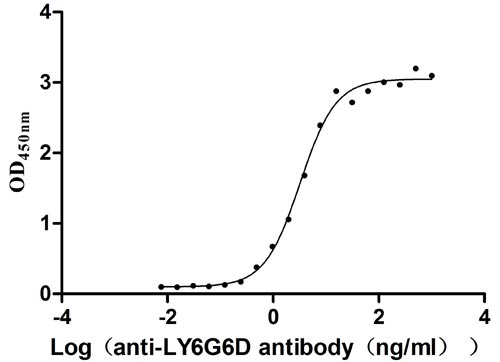Recombinant Human Dihydropyrimidinase-related protein 2 (DPYSL2)
In Stock-
货号:CSB-YP614975HU
-
规格:¥1500
-
图片:
-
(Tris-Glycine gel) Discontinuous SDS-PAGE (reduced) with 5% enrichment gel and 15% separation gel.
-
Based on the SEQUEST from database of Yeast host and target protein, the LC-MS/MS Analysis result of CSB-YP614975HU could indicate that this peptide derived from Yeast-expressed Homo sapiens (Human) DPYSL2.
-
Based on the SEQUEST from database of Yeast host and target protein, the LC-MS/MS Analysis result of CSB-YP614975HU could indicate that this peptide derived from Yeast-expressed Homo sapiens (Human) DPYSL2.
-
-
其他:
产品详情
-
纯度:Greater than 90% as determined by SDS-PAGE.
-
基因名:DPYSL2
-
Uniprot No.:
-
别名:Collapsin response mediator protein 2; Collapsin response mediator protein; Collapsin response mediator protein hCRMP 2; CRAM; CRMP 2; CRMP-2; CRMP2; DHPRP 2; DHPRP2; Dihydropyrimidinase 2; Dihydropyrimidinase like 2; Dihydropyrimidinase like 2 long form; Dihydropyrimidinase related protein 2; Dihydropyrimidinase-related protein 2; DPYL 2; DPYL2; DPYL2_HUMAN; DPYSL 2; Dpysl2; DRP-2; DRP2; Musunc 33; Musunc33; N2A3; TOAD 64; TOAD64; ULIP 2 protein; ULIP-2; Ulip2; Unc-33-like phosphoprotein 2
-
种属:Homo sapiens (Human)
-
蛋白长度:Full Length
-
来源:Yeast
-
分子量:64.3kDa
-
表达区域:1-572aa
-
氨基酸序列MSYQGKKNIPRITSDRLLIKGGKIVNDDQSFYADIYMEDGLIKQIGENLIVPGGVKTIEAHSRMVIPGGIDVHTRFQMPDQGMTSADDFFQGTKAALAGGTTMIIDHVVPEPGTSLLAAFDQWREWADSKSCCDYSLHVDISEWHKGIQEEMEALVKDHGVNSFLVYMAFKDRFQLTDCQIYEVLSVIRDIGAIAQVHAENGDIIAEEQQRILDLGITGPEGHVLSRPEEVEAEAVNRAITIANQTNCPLYITKVMSKSSAEVIAQARKKGTVVYGEPITASLGTDGSHYWSKNWAKAAAFVTSPPLSPDPTTPDFLNSLLSCGDLQVTGSAHCTFNTAQKAVGKDNFTLIPEGTNGTEERMSVIWDKAVVTGKMDENQFVAVTSTNAAKVFNLYPRKGRIAVGSDADLVIWDPDSVKTISAKTHNSSLEYNIFEGMECRGSPLVVISQGKIVLEDGTLHVTEGSGRYIPRKPFPDFVYKRIKARSRLAELRGVPRGLYDGPVCEVSVTPKTVTPASSAKTSPAKQQAPPVRNLHQSGFSLSGAQIDDNIPRRTTQRIVAPPGGRANITSLG
Note: The complete sequence including tag sequence, target protein sequence and linker sequence could be provided upon request. -
蛋白标签:N-terminal 6xHis-tagged
-
产品提供形式:Liquid or Lyophilized powder
Note: We will preferentially ship the format that we have in stock, however, if you have any special requirement for the format, please remark your requirement when placing the order, we will prepare according to your demand. -
缓冲液:Tris-based buffer,50% glycerol
-
储存条件:Store at -20°C/-80°C upon receipt, aliquoting is necessary for mutiple use. Avoid repeated freeze-thaw cycles.
-
保质期:The shelf life is related to many factors, storage state, buffer ingredients, storage temperature and the stability of the protein itself.
Generally, the shelf life of liquid form is 6 months at -20°C/-80°C. The shelf life of lyophilized form is 12 months at -20°C/-80°C. -
货期:3-7 business days
-
注意事项:Repeated freezing and thawing is not recommended. Store working aliquots at 4°C for up to one week.
-
产品描述:
An entire Dihydropyrimidinase-related protein 2 (DPYSL2) ORF inserted a 6xHis-tag at the N-terminus was expressed in the yeast cells. The generated protein is the recombinant full-length fusion DPYSL2 containing 1-572aa of human DPYSL2. The SDS-PAGE analysis measured its purity up to 90%, and it has a calculated molecular mass of 64.3 kDa. It also underwent validation by the LC-MS/MS analysis. In-stock DPYSL2 proteins are offered now. This recombinant DPYSL2 protein may find uses in the production of anti-DPYSL2 antibodies or in the studies of developmental biology.
DPYSL2, also called CRMP2, is a cytosolic protein belonging to the five-gene family known for its implication in axonal growth cone collapse. DPYSL2 mediates axonal outgrowth in the developing brain by enhancing microtubule assembly, vesicle trafficking, and synaptic physiology. DPYSL2 interacting with other proteins stabilizes microtubules, facilitates neurite outgrowth, and regulates signaling processes in the central nervous system (CNS). The ablation of DPYSL2 may lead to neurodevelopmental disorders including unregulated axon growth and branching, which suggests that DPYSL2 plays a crucial role in the pathogenesis of schizophrenia. Liu-Lin Xiong etc. demonstrated that an increase of DPYSL2 expression promotes neural stem cells (NSCs) differentiates into neurons.
-
Datasheet & COA:Please contact us to get it.
相关产品
问答及客户评论
Regarding the in-stock protein CSB-YP614975HU, could I order this protein without glycerol? Would you guys be willing to dialyze the protein to remove the glycerol? If so, how much would the cost of this service be? Or you cannot perform dialysis on such a small quantity as there will be too much loss?
Glycerol has a protective effect on protein. First, it can increase the stability of the protein (reducing the polarity of the buffer and preventing hydrophobic aggregation of the protein). Second, it can reduce the freezing point of the system and facilitate the preservation of the protein at low temperatures, especially when the protein is repeatedly frozen and thawed. Protein damage (aggregation or inactivation) can be avoided as much as possible. As for the final concentration of glycerol, in principle, the final concentration of 5%-50% has no problem, it may involve in the preservation of time, high glycerol content is relatively conducive to longer storage. However, the fianl content can be adjusted according to your request,
If you insist not to add any glycerol, we can also meet your demand, but we should disclaim in advance that without addition of glycerol may lead to protein instability, especially the protein itself is unstable.
For lyophilized protein: There isn't any glycerol added before or after the lyophilization.
Therefore we recommend you to choose lyophilized protein if you have strict requirement on the glycerol.
If you can accept the lyophilized protein, we can provide lyophilization service for free, lead time will be extended for 3 working days.
How much protein do you need ? For the current 600ug protein in stock, I'm afraid we can only provide 200ug liquid protein at most after removing the glycerol,
If you need more than 200ug liquid protein without glycerol, we have to prepare a new batch, lead time is 22-32 working days.
The lead time for 600ug lyophilized protein or less is 6-10 working days.
We are interested in ordering CSB-YP614975HU (3mg or 5mg). Since we previously requested the protein to be lyophilized, can you guarantee to provide lyophilized protein for this new potential order? If yes, how will you package this order? (Ex. 3mg or 5mg in 1 vial?)
Thank you.
What's your additional requirement for this new order ? Do you need Aseptic Processing and Endotoxin Removal besides lyophilization ?
If it must be lyophilized form, please be noted that we will add 6% trehalose as protective agent during the lyophilization process.
Regarding the package size, we will preferentially meet your demand for the package size if there is any.
If you don't have any requirement, the final package size will be determined during the manufacturing process.
The expected package size is (3mg)3x1mg vials or (5mg)5x1mg vials.
靶点详情
-
功能:Plays a role in neuronal development and polarity, as well as in axon growth and guidance, neuronal growth cone collapse and cell migration. Necessary for signaling by class 3 semaphorins and subsequent remodeling of the cytoskeleton. May play a role in endocytosis.
-
基因功能参考文献:
- cross-talk between distinct CRMP2 posttranslational modifications is a key factor in determining NaV1.7 trafficking and localization PMID: 27940916
- crystal structure of human tetrameric CRMP-2 PMID: 28044206
- increased pCRMP2 may underlie the axonal pathology of Lewy body dementias. PMID: 27609071
- These data identify a novel oncogenic mechanism where CDK5 activation induces CRMP2A phosphorylation in the nuclei of tumour cells PMID: 26555036
- polymorphisms of the DPYSL2 gene in humans may be associated with the development of schizophrenia. PMID: 25847191
- Functional variants in DPYSL2 sequence increase risk of schizophrenia and suggest a link to mTOR signaling PMID: 25416705
- Changes for CRMP2, TCP1epsilon, TPM2 and 14-3-3gamma were confirmed in experimental tumors and in a series of 28 human SI-NETs. PMID: 25224486
- Reduced CRMP2 expression and elevated expression of nuclear phosphorylated CRMP2 may be associated with breast cancer progression. PMID: 23381229
- Levels of total GSK3 were decreased in the Huntington disease-affected frontal cortex and this correlated with decreased phosphorylated CRMP2. PMID: 24634145
- High dihydropyrimidinase-related protein 2 expression is associated with lung cancer. PMID: 24518087
- genetic variants in DPYSL2 may play a role in susceptibility to alcohol dependence. PMID: 23846846
- A specific and reversible intermolecular Cys-504-Cys-504 dithiol-disulfide switch in homotetrameric CRMP2 determines two conformations of the quaternary CRMP2 complex that controls axonal outgrowth and thus neuronal development. PMID: 24133216
- CRMP-2-dependent regulation of ROCK II activity is mediated through interaction of the CRMP-2L N terminus with the ROCK II catalytic domain as well as by GSK3-dependent phosphorylation of CRMP-2. PMID: 24036111
- a novel regulatory mechanism that utilizes CRMP2 SUMOylation to choreograph NaV1.7 trafficking. PMID: 23836888
- a new insight into CRMP-2 as a controller of myosin II-mediated cellular functions through the inhibition of ROCK II in nonneuronal cells PMID: 22431514
- No Alzheimer disease-associated differences in CNP and DPYSL2 promoter DNA methylation were observed. PMID: 22954668
- Deletion analysis of CRMP-2 identified a 51 amino acid sequence in the C-terminus that is required for targeting to the basal body and primary cilium. This domain contains GSK-3beta phosphorylation sites. PMID: 23185275
- High levels of nuclear phosphorylated CRMP-2 is associated with lung cancer. PMID: 23023514
- CRMP2 hyperphosphorylation is speci fi c to Alzheimer's disease and is not a common event in all forms of dementia and neurodegeneration, especially other tauopathies. PMID: 21860090
- findings suggest a major role of phosphorylated CRMP-2 as a mechanism involved in process retraction induced by reactive oxygen species PMID: 22443207
- HTLV-1 has the capacity to influence the CRMP2/PI3K/Akt axis thus to positively control cytoskeleton organization and lymphocyte migration. PMID: 22227566
- CRMP2 controls dendritic projection; the phosphorylation of CRMP2 at Ser522 is essential for proper dendritic field organization for axonal guidance and spine development . PMID: 22279220
- This review discusses the essential biology of CRMP2 in the context of nascent data implicating CRMP2 perturbations as either a correlate of, or plausible contributor to, diverse neuropathologies. PMID: 21271304
- Data support DPYSL2 and the surrounding genomic region as a susceptibility locus for schizophrenia. PMID: 21302347
- Data provide the first trafficking regulatory role for Crmp2 in non-neuronal cells and support a model in which Crmp2 is an important endocytic regulatory protein that links MICAL-L1.EHD1-based vesicular transport to dynein motors. PMID: 20801876
- DPYSL2 does not have a major function in schizophrenia in Japanese subjects. PMID: 20414250
- CRMP2 as a tubulin direct binder may be a GTPase-activating protein (GAP) of tubulin in neurite formation and its GAP activity may be regulated by an intramolecular interaction with an N-terminal inhibitory region. PMID: 19666111
- Aberrant expression of dihydropyrimidinase related proteins-2,-3 and -4 in fetal Down syndrome brain. PMID: 11771764
- No significant associations were found between five polymorphisms of the DRP-2 gene and Bipolar Disorder, nor were associations detected between either of the polymorphisms and bipolar subtypes I and II. PMID: 12951196
- Here we show that glial cell line-derived neurotrophic factor (GDNF) enhances CRMP-2 expression in TGW human neuroblastoma cells via activation of RET receptor tyrosine kinase. PMID: 15207709
- significant decrease of crmp-2 protein may represent or underlie impaired neuronal plasticity, neurodegeneration, wiring of the brain in mesial temporal lobe epilepsy PMID: 15672539
- CRMP-2 transports the Sra-1/WAVE1 complex to axons in a kinesin-1-dependent manner and thereby regulates axon outgrowth and formation PMID: 16260607
- collapsin response mediator protein-2 transcriptional activity is inhibited by all-trans-retinoic acid during SH-SY5Y neuroblastoma cell differentiation PMID: 17229153
- These observations implicate hyperphosphorylation of CRMP2 as an early event in the development of AD and suggest that it can be induced by a severe APP over-expression and/or processing defect. PMID: 17683481
- results indicate that that CRMP-2 may be a novel colorectal cancer biomarker PMID: 18203259
- association of neurofibromin and CRMP-2 is essential for neuronal cell differentiation PMID: 18218617
- relative resistance to phosphatases might be a common feature of Cdk5 substrates and could contribute to the hyperphosphorylation of CRMP2 and Tau observed in Alzheimer disease PMID: 18460467
- Data suggest that collapsin response mediator protein-2 (CRMP-2) is a novel calmodulin-binding protein and that CaM binding may play an important role in regulating CRMP-2 functions. PMID: 19151921
- Given that CRMP-2 is a key regulator of axon elongation, this interference with cytoplasmic dynein function by CRMP-2 might have an important role in axon formation, and neuronal development PMID: 19659462
- A significant association was found between a single nucleotide polymorphism of the DRP-2 gene and schizophrenia in a North American sample. PMID: 15858820
显示更多
收起更多
-
亚细胞定位:Cytoplasm, cytosol. Cytoplasm, cytoskeleton. Membrane. Note=Tightly but non-covalently associated with membranes.
-
蛋白家族:Metallo-dependent hydrolases superfamily, Hydantoinase/dihydropyrimidinase family
-
组织特异性:Ubiquitous.
-
数据库链接:
HGNC: 3014
OMIM: 602463
KEGG: hsa:1808
STRING: 9606.ENSP00000309539
UniGene: Hs.593187
Most popular with customers
-
Recombinant Human Tumor necrosis factor receptor superfamily member 1B (TNFRSF1B), partial (Active)
Express system: Mammalian cell
Species: Homo sapiens (Human)
-
Recombinant Human B- and T-lymphocyte attenuator (BTLA), partial (Active)
Express system: Mammalian cell
Species: Homo sapiens (Human)
-
Recombinant Macaca fascicularis Delta-like protein 3 (DLL3), partial (Active)
Express system: Mammalian cell
Species: Macaca fascicularis (Crab-eating macaque) (Cynomolgus monkey)
-
Recombinant Human Prolactin receptor (PRLR), partial (Active)
Express system: Mammalian cell
Species: Homo sapiens (Human)
-
Express system: Mammalian cell
Species: Homo sapiens (Human)
-
Recombinant Human Lymphocyte antigen 6 complex locus protein G6d (LY6G6D) (Active)
Express system: Yeast
Species: Homo sapiens (Human)
-
Recombinant Human Desmoglein-3 (DSG3), partial (Active)
Express system: Baculovirus
Species: Homo sapiens (Human)
-
Recombinant Human Cadherin-1(CDH1),partial (Active)
Express system: Mammalian cell
Species: Homo sapiens (Human)























